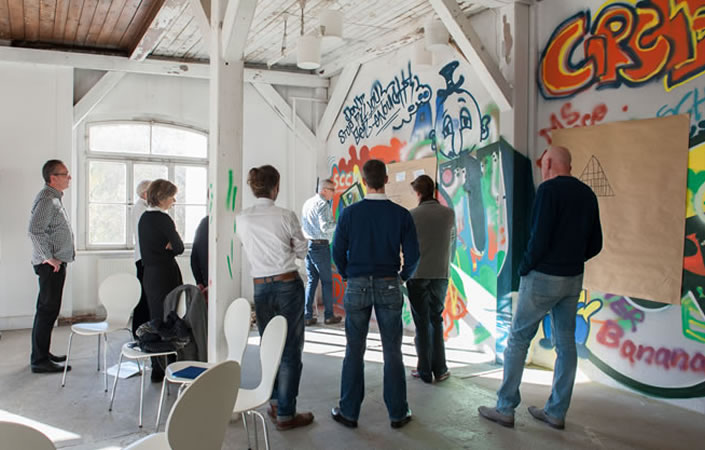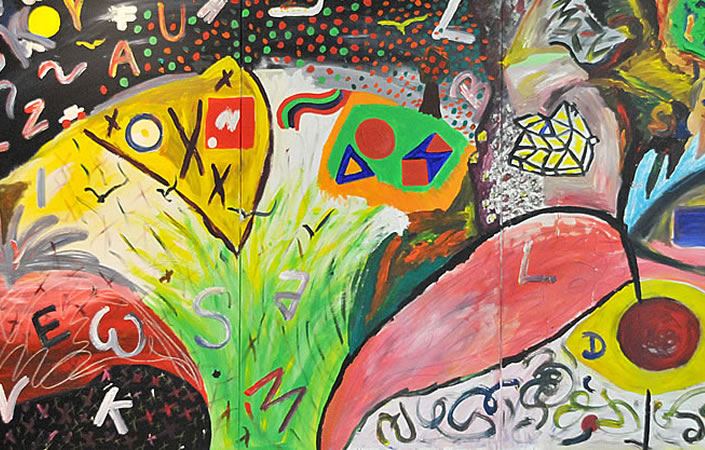1. June 2017

Looking up at a starry sky, we might have a sense of sublime peace and magnitude or hear the music of the spheres. They are ways to look or hear into the sky; images we create for ourselves. Heinrich Hertz, as a hardcore natural scientist, noted that we create images of things for ourselves that contain but an indication, in order more or less to fulfil our desire for explanations and increase or range of options. Hertz thereby dissolves the bi-fold world view that juxtaposes »The world is fact and matter« with »The world is words and stories«: every insight, every image of reality is but a potential and only valid as long as it is useful and cannot be proved wrong. They are images that describe and order our experiences with the world. They change as soon as other perspectives appear to be more effective.
In organizational development, we are currently facing such a change. All image changes have a great impact on the behaviour and actions demanded of us. How can we describe this image change?
A first, very effective, dichotomy in the description of companies began with just one word: value-adding. Over night, attitudes changed: significant functions were no longer value-adding and their value became the support of value-adding fields. It was a reassessment that at the same time opened the doors to lean thinking. Generations of managers learned that the art of management was the reduction of effort and a consistent awareness of efficiency. The daily bread of leadership were costs and their reduction, development of ever leaner processes and their reproduction. Thus emerged an ‘image’ of leadership and excellent organization, as well as an unprecedented race for the lowest cost.
We are now experiencing a new dichotomy. This one can be summed up with the terminological pair agility/excellence (the euphemism for a radical lean concept). It separates the organization into two distinctively separate enterprises, on the one side a turnout or supply chain organization and on the other side the organization dealing with innovation, product and business models. The latter is described as agile, acts in smaller units, is close to the market. This second dichotomy has been explained with the push for digitalization, a reverse push for globalization, the transition to a knowledge society. We consider it a reaction to the expectation of non-linear events, which even smart data are blind to. To put it more fashionably: disruptivity. This ever more urgent expectation that something unforeseen will happen and redefine the game is causing companies to react with their goal to themselves be the source of disruption: to be innovative, or at least highly adaptive, i.e., to be agile.
Such a goal cannot be achieved in organizations with many hierarchical levels and with the classic European-American planning and strategic logic. It requires the introduction of incremental forms of work and planning, working with vision spaces and setting goals of wastefulness as well as cost and achievement. The difference within the second dichotomy is most apparent at hand of the meaning of mistakes. In the supply organization, mistakes were and are planning and process mistakes, they are an interruption of the well-controlled and must be eradicated immediately and for good.
In agile organizations, mistakes are a ladder that can lead to the new; they are a necessary part of flexible trials, which lead to new learning. The mistake leads to further understanding. Therefore, playing becomes a leading principle for agile organizations, which can resort to notions of the Classicist period, e.g. Friedrich Schiller’s remark that a human is only human, in full possession of his and her entire potential, at play. This »other« form and logic of work applies only, however, where the event is imminent or hoped-for. The supply chain organization still maintains the reliable logic of planning, process and standardization.
As organizational developers, we tend to pounce on the new, the second side of the dichotomy, and sometimes neglect that the first side of the dichotomy, the old, is and remains the basis. The psychological reactions we experience are similar to those we saw during the first dichotomy, the differentiation between value-adding and non-value-adding: feelings of devaluation on the one side and a powerful, euphoric narcissism on the other side.
What does that mean for us? We also need to match the support we offer to this dichotomy. What are the psychological, motivational needs of the supply chain organization? It will not be possible to alter the organizational units necessary for success into a culture that corresponds to Amazon warehouses or Apple’s Foxcom organization. Even in a radical lean concept, we will have to win the heads and hearts of the people. That is all the more true as employees are required to have a decidedly higher degree of education within industry 4.0. Next to flexible education concepts, which are available in combination with blended learning approaches, we believe that we need a powerful revitalization of Kaizen: after all, the crux of these approaches is not and was never the achieved savings potential, but their motivating power by the way they foster taking responsibility. Self-efficacy has to be possible even in these highly standardized workplaces. It would be a great mistake to undervalue the human factor in the supply chain organization for the sake of efficiency.
Both attention and money are currently being primarily fed into the agile parts of the organization – method training (scrum/design thinking) is flourishing as much as the trying of new organizational forms. Manifold questions on leadership of self-organized units, etc., are addressed and offers of support are developed for teams and relatively independent units such as, e.g., the »agile coach«. We see that it can be very enriching and pleasing to work in such relatively free teams, but that it is also exhausting and sometimes threatening to be in this form of social dynamic, devoid as it is of the protective character of leadership. Amid the plethora of supervision options, it is clear that a one-off team training will not suffice. Group dynamic is dynamic and it runs an irrational course, so we consider internal and external permanent supervision. Again, blended learning can provide an additional element of support.
At the same time, an agile form of working brings up a range of organizational questions. At first, these were limited to the transition from a project team to an agile team. By now, the entire organization needs to be considered: hierarchical levels become superfluous, a whole range of questions of control and transparency remain open, hence the unrest is manifold. Responsibility and freedom of action is to be moved to the edges of the organization, so that the organization is seen in its breadth rather than in the height of the pyramid.
We are beginning to learn how such organizations work and are lead. To boot, we expect that parts of organizations are hooked up to the business although they are not classically part of it – that complicates the task of the leadership even further. Is it enough to point out charismatic leaders, who are so very much in fashion in politics at the moment? Or do we need a more in-depth re-definition of leadership behaviour, an abstract and fragmented notion of which we can find in the concepts of transformational leadership?
We take a single aspect: agility – the description of an organization that acts flexibly, fast, with many ideas and taking responsibility – is only possible when the company lives the diversity of it own employees. That means that differences are not normatively blurred, but that instead the ‘otherness’ of difference is consistently addressed. This is the only way in which it can fulfil one of the great hopes that are connected with an agile organization: that it depicts the trends, expectations and movements in society within it and aids their understanding. That is the state a company striving to be innovative and highly adaptive aims for.
What is often underestimated is the effect on the companies of what we know as governance and service units – they will have to offer platforms in future that allow a range of units with a variety of support needs to hook up. This is a place of excellence that provides its own achievements to the agile units. These units need to free themselves from the constant discussion that they are not assertive enough and grow into becoming providers of auxiliary, also flexible, solutions.
Not least, an organization that is steadily ahead of itself in order to be able to be what it will need to be can remind us of the place an »enterprise« ought to have in societies. People have questions of meaning, people want to live in a context that does not tax their conscience – we are able to engage in much self-deceit in this matter. Yet there remains a basic standard: my organization should be a good place – and in an agile world, that should be true not only within the borders of the company, but in its manifold connections with societies.
Companies will therefore hardly be able to avoid the following questions again and again: why does society tolerate our striving for profit? What is it we provide that gives us the right to egotistical striving to profit? Pharmaceutical companies putting their money into the development of medicine for children know that that is not where the big profits are, but they can chose to do so because they have a duty – free to choose, but imperative in the absolute – to be of use to the whole. Looking into the world, are not the big corporations one of the few places where global questions are negotiated? Or when did you last hear the UN mentioned on the news?
Rüdiger Müngersdorff
3. February 2017

The demands on organisations are growing steadily, while the private and business world is becoming more complex and increasingly less predictable. As the recent past has clearly shown, we are challenged daily by issues which are always good for surprises: not only digitalisation as one of the big drivers, but also other trends, such as urbanisation, progressive globalisation, environmental issues and political developments.
Many companies are rather ill-prepared for these developments and do not adequately use their own potential or the knowledge of employees who are, in fact, highly qualified. Very often, they continue with previously successful behaviour and react to new requirements with known patterns. Above all, management still largely uses methods which originated in the industrial age and are often not suited to meet the new requirements. Although the insight is fundamentally there and this is repeatedly confirmed at many of the countless conferences, in reality, little has changed so far, and if so, then rather slowly.
Why is that? Why is this existing knowledge not translated to the extent necessary? The answer is relatively simple: classical management principles have been successful in the old world for many decades. To replace or change them would mean entering upon unknown terrain and taking a risk. This leads to great uncertainty, particularly for organisations that have grown over many years. After all, there is an existing business that should not be placed in danger. Where and how do we start?
Experience shows that either detailed knowledge about the condition of one’s own organisation is very often lacking, or the assessments and pictures diverge considerably at the upper management level. Often, there is also a lack of information regarding where a successful intervention can be put in place, or there are negative experiences with change projects which are rather ineffective in the end. Management development, insofar as it exists as a solid element, often fails to achieve the desired effect, which is then a clear signal for missed or inadequate implementation measures. Causes and connections between these often observed effects are complex and mostly not obvious at first sight.
In an increasingly dynamic (VUCA-) environment, where corporate management is becoming more and more demanding, established recipes and procedures, which are often still based on stable and (therefore) more predictable times, are rather bad. Or they are completely ineffective because they provide the wrong answers to current challenges.
A typical example of this is the still-widespread instrument of management by objectives (MbO). Targets have often already been surpassed when they are agreed upon or, after a short time, they no longer fit into the changed requirements of the business. New developments that arise asynchronously, i.e. within the target period, cannot be addressed appropriately if they do not match the previously agreed targets, which often leads to a lack of resources, budget, etc. Moreover, a consistent goal development of the individual employee often leads to the self-optimisation of the individual rather than the company (division).
Effects such as these are numerous; They often establish themselves over years, creep unwittingly and unintentionally as increasingly larger disturbances against the backdrop of a changing environment and ultimately become manifested as part of an enterprise culture. Changing this is extremely difficult and ultimately only possible through a changed management.
Leaders have the responsibility of creating an environment with as few disturbances as possible so that peak performance can be achieved. The most important first step is the development of precise knowledge about the nature and effect of these »disturbances« through a complete and comprehensive analysis of the status quo. In order to make such an analysis meaningful, a comprehensive (management) model is needed which takes into account the most important aspects and their interactions within the company context.
 The performance triangle, developed over years by Lukas Michel and his worldwide Agility Insights-Netzwerk, is such a scientifically based model that creates a bridge between the skills of people and the challenges of organisations.
The performance triangle, developed over years by Lukas Michel and his worldwide Agility Insights-Netzwerk, is such a scientifically based model that creates a bridge between the skills of people and the challenges of organisations.
The core idea is to identify future organisational skills at an early stage so that the necessary talent, teams and structures can be developed.
People with their talents and abilities are the heart of the triangle. In the sense that »self-responsibility is an essential foundation for knowledge, work and motivation« (Peter F. Drucker) and that »trust leads« (Reinhard K. Sprenger), this promotes the speed in organisations through competent decisions on the customer front, the use of the knowledge of capable employees and management that primarily acts as an enabler.
Culture, leadership and systems form the corners of the triangle. Good decisions and effective actions require a culture that creates a common context. Management has to actively promote dialogue and interaction via purpose, orientation and performance. Systems have to work diagnostically to draw attention to what is important and to make corrections possible at any time. Intensive interactions and diagnostic control are fundamental abilities of agile organisations, since they enable early detection and interpretation of signals and corresponding actions.
Above all, in addition to knowledge, what is required for good decisions by people is purpose, which is at the same time a decisive basis for intrinsic motivation. Internal and external relationships help to continually develop and exchange this knowledge and to utilise it as added value for the customer. Combined knowledge, the collective experience and the shared benefit from it allow new developments and promote innovative power. Purpose, co-operation and relationships are the organisational skills that help to be able to absorb the shock of unexpected external shocks and influences. They are the sides that hold together the triangle of culture, leadership and systems.

Via speed, agility and resilience, the performance triangle leads to the ability to take action. Organisations with these skills use the knowledge in the networks of employees while at the same time creating the organisational skills to deal with the dynamics of the environment as effectively as possible.
Companies with an effective management that actively shapes their own organisation for their (knowledge) employees and places people at the centre have the potential to emerge as winners of the new era.
Diagnostic mentoring is the process that allows the systematic development of these dynamic skills. It is based on 3 steps:

- Decoding
Analysis of the existing capabilities by comprehensive diagnostics and benchmarking (on-line tool)
- Designing
Creating the target image of the future organisational skills (CEO briefing and executive team workshops)
- Development
Creating change steps and their implementation via the performance triangle with the involvement of the operative organisation (mentoring and day workshops)
Even if there is a wealth of tools and support from specially trained mentors from the Agility Insights network, this further development for the affected companies always involves a transformation that fundamentally changes behaviour and competencies, puts existing issues into question, interferes with established processes and, therefore, always involves risks.
A fundamental development affects decision-making competences. Within the scope of further development, managers have to decide
- How they want to involve or incorporate employees
- How work is to be coordinated and guided
- How goals are set and pursued
- How changes/adaptations are made
- How decisions are made
For each of these 5 key questions, it is necessary to select and establish either
a) more self-responsibility on the part of employees or
b) control by the executive management.
Depending on the combination of the answers, different concepts for the management and the organisation arise.
This »work on the system«, the correct design of leadership and organisation, is not a task for the workforce or the lower and middle management. It cannot be delegated, but rather has to begin at the top of an organisation in the executive team.
In the beginning, a clean diagnosis, analysis and interpretation of the results as well as consensus responses to the five principle questions mentioned above are performed. Only then does the concretisation in the different functional areas of the organisation and the formulation of precise interventions begin.
It is and remains the responsibility of the executive management to decide how to address the necessary changes in order to activate the potential and implement it for the benefit of the organisation, the customers and the business.
Rüdiger Schönbohm
TYSCON Management Consulting & Business Partner Agility Insights
Pictures and individual text passages
© Agility Insights AG, 2016 / Cover picture: Pixabay
13. July 2016

I described the fundamental aspects of agile talent management in my last blog post on the topic of talent management: a development-guided notion of talent, talent enabling, self-organization and a supportive talent culture. Building on that, I will now propose further thoughts on actually implementing these in a company.
Talent management with flexible formats
In agile environments, talent management – or rather talent enabling – needs to be dynamic instead of process-driven. We therefore have to question specified annual cycles of talent management. There is little point to conducting employee conversations at pre-set points in time when work structures undergo dynamic change and project cycles take the form of thirty day sprints. The format of the employee conversation is still an important tool in principle. It does not do, however, to use it as a mere step within a process. In other words, feedback is provided, individual development desires and training requirements are talked about and employees are evaluated whenever there is an occasion to do so. The timing is variable, as are the persons who are invited into the setting. Team colleagues may be included, where necessary. Employees and managers have to be enabled to apply these formats for talent flexibly and apply them in their own manner as required.
Talent management software must not be the structural guide for talent development. This is even more true now than it was in traditional forms of organizations. Interaction and learning by experience are pivotal. A a result, talent management and its supporting systems gain a new flexibility. Adaptable and accessible formats for talent are more important than one continuous talent process.
New roles in intrinsic career management
My previous contribution described development-guided behavior and self-organization in talent management; these create a demand for new skills in an organization. Employees now shoulder more responsibility for themselves and their career development. In traditional companies, career planning is often still based on the mechanism of the system: pre-ordained career paths, promotion cycles, appointments as high potential, which will surely deliver the employees – given good work – to the correct (and crucial) position in the organization. Linear formats of this kind no longer work in agile environments. The employees need to establish their own profile of competence by themselves, as well as being able to name their personal motivation and values truthfully and in detail in order to deduce from these their career goals and action plans. It takes a new way of thinking and acting to be able to perform this kind of self-direction. The employees can be supported in their self-organization by way of staff offers with regard to career planning. Such offers include, e.g., position reckoning, peer coaching, job shadowing and mentoring.
Managers will also have to rethink and assume their role as a talent coach. As a professional coach does, they do not decide career questions, but are required to accompany the employee with regular feedback and negotiation that takes into account the available capabilities. They help to identify fields for development and to attain learning goals, they make educational offers, e.g, for new projects. Managers may need support in order to implement this role. This can come in the form of training. However, what is required is not only the attainment of concrete skills but also a new understanding of the management role, as is generally true for agile organizations. As in other fields, the managers will assume a moderating and supporting function in talent management.
Agile talent management requires new formats and interventions. New attitudes and roles need to be assumed and accepted so that flexibility and personal responsibility can be implemented successfully.
Anke Wolf
30. June 2016

The form of talent management I witness in many organizations is maintained via talent identification and process management. Yet, these inflexible models are rarely able to permit the flexibility that is required in complex, agile environments. If talent management means to tap and foster employee potential in new forms of organization as well, it must leave behind the old, linear ways of thinking and acting and, like the business itself, become non-linear, agile and flexible.
Development-guided notion of talent
A development-guided notion of talent is a helpful addition in this context. In contrast to a static notion of talent, the development-guided understanding does not focus primarily on such categories as talent and high potential. It considers all employees and kinds of talent, essentially the »power of the many« and not the »vital few«. It is a way of maintaining performance and innovation in an uncertain and dynamic situation: by mobilizing the entire staff, distributing the risk and having an experimental attitude.
Differences in performance and potential should not be denied, but considered subject to alteration across time as well as situations. Stanford professor Dr. Carol Dweck demonstrated a startling effect in studies and examples: The mere conviction that abilities can fundamentally always be improved by way of effort and learning by experience has a surprisingly positive influence on individual learning achievements and eventually also the success of a business. Rigid categories of talent and intelligence are more likely to result in status thinking and eventually in standstill (Carol Dweck: Mindset. Changing the way you think to fulfill your potential).
Being guided by development also means that talent management in agile environments is less predictable and more iterative. The aspect of »management«, meaning direction, loses its primacy and can be replaced by »enabling«. Talent enabling is a more appropriate term to describe the way companies enable their employees to free their potential and make this potential available for the company.
Self-organization in talent management
Development-guided talent enabling will profit from concepts such as »learning agility« (a.o. Center for Creative Leadership). The skills entailed in learning agility include the ability to question the status quo, to learn from experience, as well as reflection, feedback and the willingness to take risks. These aspects are surprisingly reminiscent of a SCRUM Sprint. There is little room for rigid formats like career paths. This is so not only because career paths appear to be of little benefit in a fast-changing environment with fluid roles, but even more so because agile organizations live off their employees’ self-guidance and intrinsic motivation. Self-organization means giving the employees responsibility for their development while still remaining at the helm as a company and especially as a manager. Self-organization in the sense of learning agility means that employees identify the need to learn and expand their skill set by learning from experience, reflection and feedback; in that context, it falls to the manager as the person accompanying this process to provide stimuli, give feedback and actively offer learning opportunities. The company as a whole also needs to foster a comprehensive talent culture that goes beyond role descriptions and organization charts to value and sponsor employee learning, trial and error (yes, also the latter), and reflection.
Talent management in agile organizations therefore requires new terminology, new attitudes and a culture that adopts and integrates the company’s own non-linear development.
Anke Wolf
Coinciding with this article we are pleased to introduce one of our associated partners: Anke Wolf from Anke Wolf Coaching & Consulting is a recognized expert in talent management and leadership.
25. February 2016

In Berlin, people are queueing up to see an exhibition comparing expressionist and impressionist painting. It is a very regulated experience of art: this is well established, known art. There will not be any exceeding challenges, irritations or surprises. Here, on the other hand, it is quiet and empty. Nobody knows yet what these sculptures and performances might have to say. These sculptures have not yet been classified and are on display without a commentary. The exhibition in Berlin puts the spotlight on something that is known and has been evaluated. We, on the other hand, are encountering something different here: openness and the undefined. We have to find our own position; there is no official interpretation to relieve us of having to have the courage of our own opinion. We have to give our own judgement.
Companies are nowadays almost desperately searching for innovation, vibrancy, creativity and agility. Such places as these here can show us the prerequisite: the ability to open up for something that has not yet been tested, which is definitely not »more of the same«: something provocatively different. Something that instigates conflict, causes uncertainty and that is risky to evaluate.
This kind of context allows for new experiences and may give way to new perspectives. These visits are a metaphor for companies. They demand some distance from the tried and tested. That is one of the reasons I love these places. Here, I can feel that I also have the right to stand in front of a sculpture and be utterly clueless as to what it might tell me. And to then go on to discover another one that opens up a new perspective.
What does that have to do with companies, you might ask. I still experience companies attempting to be transnational – often successfully so. Leadership is considered to be a globally defined behaviour, the approach is inclusive. Groups from a wide range of cultures are learning to apply this model behaviour. However, while companies may be transnational and culturally global, the markets are multinational and are in fact in the process of becoming even more »multi« and diverse again. Like the pieces of art in this space, they contain difference, surprise, strangeness and sometimes provocation.
In my extensive travels throughout Asia and my encounters with many people at work, I have learned that we need to concentrate more on »multi« than on »trans« or »mono«. By retreating into trusted knowledge and established patterns, we will never meet the diverse otherness of cultures and ways of life. Our introverted orientation will fail to direct us to the dynamics of our dazzlingly diverse world and its needs.
Let us return to innovation, agility, flexibility: in order to be able to create a culture of openness, one must expose oneself to the new and yet uninscribed and allow it into our midst. Of course there are things I do not understand, things that leave me clueless and looking for what I know – and yet at the same time I am aware that it is these very encounters with the »other than I« that give me an understanding of difference. I realize that it takes internal difference for us to be able to cope with the diversity of the outside, which requires vibrant and creative adaptation.
Rüdiger Müngersdorff



 The performance triangle, developed over years by Lukas Michel and his worldwide
The performance triangle, developed over years by Lukas Michel and his worldwide 



